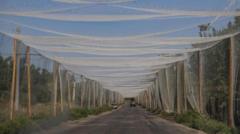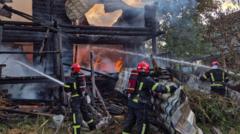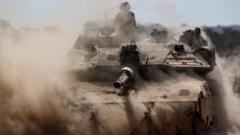The ongoing conflict in Ukraine highlights the strategic significance of the Donetsk region, which Russia aims to capture completely. While Ukraine still controls a portion of this critical territory, its defensive infrastructure and geographical challenges play a vital role in the country's ongoing resistance to Russian advances.
The Strategic Importance of Donetsk in Ukraine's Defense Strategy

The Strategic Importance of Donetsk in Ukraine's Defense Strategy
As Russia seeks to solidify control over Donetsk, Ukraine's military fortifications and geographical advantages in the region stand critical to its defense against potential further incursions.
In a recent summit in Alaska, Russian President Vladimir Putin expressed intentions to stabilize the conflict in Ukraine by freezing the war along the current front lines while demanding the surrender of the remaining areas in Donetsk. Presently, after over a decade of conflict, Russia dominates around 70% of the Donetsk region (oblast), including its capital, cementing its claim to the territory while minimizing additional military casualties.
For Ukraine, relinquishing control of western Donetsk not only results in substantial territorial loss but also risks a new wave of refugees and diminishes a crucial barrier against further Russian offensives. The importance of Donetsk's military and economic prospects is paramount, with Ukraine still holding approximately 6,600 square kilometers (2,548 sq miles) of land, where around a quarter-million residents remain in major cities like Kramatorsk, Slovyansk, and Kostyantynivka.
The local economy has suffered immensely due to ongoing warfare, with experts suggesting that recovery will take years, hindered by landmines. A report from the Institute for the Study of War indicates that Ukraine has constructed a "fortress belt" through western Donetsk, reflecting over a decade of effort to bolster defenses, including extensive trench systems, bunkers, and various military fortifications.
Military analysts emphasize the challenging topography in the region. While the terrain offers some defensibility, including control over high grounds like Chasiv Yar, the overall landscape in eastern Ukraine is disadvantageous for Ukrainian forces, complicating defensive maneuvers and artillery coordination.
Despite ongoing Russian aggression in the area, the strategic landscape presents significant barriers for them as well. The Donetsk front line, merely a fragment of the broader 1,100km frontline, has witnessed fierce fighting, but analysts suggest that a redirection of Russian forces to other fronts would likely yield minimal progress due to similar defensive fortifications elsewhere.
If Ukraine were to negotiate a peace settlement, they might theoretically relocate their defense further west, yet the terrain poses further challenges, and rebuilding efforts would demand considerable time and resources. Ukrainian President Volodymyr Zelensky has made it clear that the government will refuse any negotiations to surrender Donbas territory for a ceasefire, reinforcing the belief that this region could facilitate renewed assaults in the future.
As the conflict escalates, the world watches closely, understanding that the fate of Donetsk is not just a local issue but a key battleground with broader implications for regional stability and security.
For Ukraine, relinquishing control of western Donetsk not only results in substantial territorial loss but also risks a new wave of refugees and diminishes a crucial barrier against further Russian offensives. The importance of Donetsk's military and economic prospects is paramount, with Ukraine still holding approximately 6,600 square kilometers (2,548 sq miles) of land, where around a quarter-million residents remain in major cities like Kramatorsk, Slovyansk, and Kostyantynivka.
The local economy has suffered immensely due to ongoing warfare, with experts suggesting that recovery will take years, hindered by landmines. A report from the Institute for the Study of War indicates that Ukraine has constructed a "fortress belt" through western Donetsk, reflecting over a decade of effort to bolster defenses, including extensive trench systems, bunkers, and various military fortifications.
Military analysts emphasize the challenging topography in the region. While the terrain offers some defensibility, including control over high grounds like Chasiv Yar, the overall landscape in eastern Ukraine is disadvantageous for Ukrainian forces, complicating defensive maneuvers and artillery coordination.
Despite ongoing Russian aggression in the area, the strategic landscape presents significant barriers for them as well. The Donetsk front line, merely a fragment of the broader 1,100km frontline, has witnessed fierce fighting, but analysts suggest that a redirection of Russian forces to other fronts would likely yield minimal progress due to similar defensive fortifications elsewhere.
If Ukraine were to negotiate a peace settlement, they might theoretically relocate their defense further west, yet the terrain poses further challenges, and rebuilding efforts would demand considerable time and resources. Ukrainian President Volodymyr Zelensky has made it clear that the government will refuse any negotiations to surrender Donbas territory for a ceasefire, reinforcing the belief that this region could facilitate renewed assaults in the future.
As the conflict escalates, the world watches closely, understanding that the fate of Donetsk is not just a local issue but a key battleground with broader implications for regional stability and security.



















